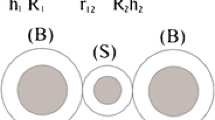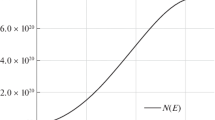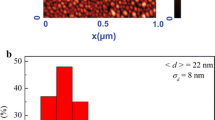Abstract
We propose an optodynamical model of interaction of pulsed laser radiation with aggregates of spherical metallic nanoparticles embedded into host media. The model takes into account polydispersity of particles, pair interactions between the particles, dissipation of absorbed energy, heating and melting of the metallic core of particles and of their polymer adsorption layers, and heat exchange between electron and ion components of the particle material as well as heat exchange with the interparticle medium. Temperature dependence of the electron relaxation constant of the particle material and the effect of this dependence on interaction of nanoparticles with laser radiation are first taken into consideration. We study in detail light-induced processes in the simplest resonant domains of multiparticle aggregates consisting of two particles of an arbitrary size in aqueous medium. Optical interparticle forces are realized due to the light-induced dipole interaction. The dipole moment of each particle is calculated by the coupled dipole method (with correction for the effect of higher multipoles). We determined the role of various interrelated factors leading to photomodification of resonant domains and found an essential difference in the photomodification mechanisms between polydisperse and monodisperse nanostructures.






Similar content being viewed by others
References
U. Kreibig, M. Vollmer, Optical Properties of Metal Clusters (Springer, Berlin, 1995)
V.M. Shalaev, Phys. Rep. 272, 61 (1996)
V.M. Shalaev, Nonlinear Optics of Random Media: Fractal Composites and Metal-Dielectric Films (Springer, Berlin, 2000)
S.V. Karpov, V.V. Slabko, Optical and Photophysical Properties of Fractal-Structured Metal Sols (Russian Academy of Sciences, Siberian Branch, Novosibirsk, 2003)
M.I. Stockman, L.N. Pandey, T.F. George, Enhanced Nonlinear-Optical Responses of Disordered Clusters and Composites in Nonlinear Optical Materials (Springer, New York, 1998)
A.P. Gavrilyuk, S.V. Karpov, Appl. Phys. B 97, 163 (2009)
S.V. Karpov, A.K. Popov, S.G. Rautian, V.P. Safonov, V.V. Slabko, V.M. Shalaev, M.I. Shtokman, JETP Lett. 48, 571 (1988)
E.Y. Danilova, S.G. Rautian, V.P. Drachev, S.V. Perminov, Bull. Russ. Acad. Sci. (Phys.) 60, 18 (1996)
E.Y. Danilova, S.G. Rautian, V.P. Safonov, Bull. Russ. Acad. Sci. (Phys.) 60, 56 (1996)
V.P. Safonov, V.M. Shalaev, V.M. Markel, Y.E. Danilova, N.N. Lepeskin, W. Kim, S.G. Rautian, R.L. Armstrong, Phys. Rev. Lett. 80, 1102 (1998)
S.V. Karpov, V.V. Slabko, A.K. Popov, Tech. Phys. 48, 749 (2003)
S.V. Karpov, M.K. Kodirov, A.I. Ryasnyanski, V.V. Slabko, Quantum Electron. 31, 904 (2001)
S.V. Karpov, V.S. Gerasimov, I.L. Isaev, V.A. Markel, Phys. Rev. B 72, 205425 (2005)
S.V. Karpov, V.S. Gerasimov, I.L. Isaev, O.P. Podavalova, V.V. Slabko, Colloid J. 69, 178 (2007)
A.P. Gavrilyuk, S.V. Karpov, Appl. Phys. B 102, 65 (2011)
V.P. Drachev, S.V. Perminov, S.G. Rautian, V.P. Safonov, J. Exp. Theor. Phys. 94, 901 (2002)
S.V. Perminov, V.P. Drachev, S.G. Rautian, Opt. Express 15, 8639 (2007)
S.V. Perminov, V.P. Drachev, S.G. Rautian, Opt. Lett. 33, 2998 (2008)
S.V. Perminov, V.P. Drachev, Opt. Spectrosc. 107, 987 (2009)
S.V. Karpov, V.V. Slabko, G.A. Chiganova, Colloid J. 64, 474 (2002)
J. Možina, J. Diaci, Appl. Phys. B 105, 557 (2011)
J. Možina, R. Hrovatin, Prog. Nat. Sci. 6, S709 (1996)
R.A. Ganeev, A.I. Ryasnyanski, S.R. Kamalov, M.K. Kodirov, T.J. Usmanov, Phys. D Appl. Phys. 34, 1602 (2001)
V.A. Podolskiy, A.K. Sarychev, E.E. Narimanov, V.M. Shalaev, J. Opt. A 7, 32 (2005)
V.A. Markel, A.K. Sarychev, Phys. Rev. B 75, 085426 (2007)
A.A. Govyadinov, V.A. Markel, Phys. Rev. B 78, 035403 (2008)
W.H. Weber, G.W. Ford, Phys. Rev. B 70, 125429 (2004)
S.V. Karpov, I.L. Isaev, A.P. Gavrilyuk, A.S. Grachev, V.S. Gerasimov, Colloid J. 71, 314 (2009)
L.D. Landau, E.M. Lifshits, The Theory of Elasticity. Course of Theoretical Physics (Nauka, Moskow, 1987)
Y.S. Barash, The van der Waals Forces (Nauka, Moskow, 1988)
F. Claro, R. Rojas, Appl. Phys. Lett. 65, 2643 (1994)
V.A. Markel, V.M. Shalaev, E.B. Stechel, W. Kim, R.L. Armstrong, Phys. Rev. B 53, 2425 (1996)
V.A. Markel, V.N. Pustovit, S.V. Karpov, A.V. Obuschenko, V.S. Gerasimov, I.L. Isaev, Phys. Rev. B 70, 054202 (2004)
A.E. Ershov, I.L. Isaev, P.N. Semina, V.A. Markel, S.V. Karpov, Phys. Rev. B 85, 045421-1 (2012)
P.B. Johnson, R.W. Christy, Phys. Rev. B 6, 4370 (1972)
C. Kittel, Introduction to Solid State Physics (Wiley, New York, 1971)
M. Otter, Z. Phys. 161, 539 (1961)
J.C. Miller, Philos. Mag. 20, 1115 (1969)
O.B. Wright, Phys. Rev. B 49, 9985 (1994)
T. Castro, R. Reifenberger, E. Choi, R.P. Andres, Phys. Rev. B 42, 8548 (1990)
C.-K. Sun, F. Vallée, L.H. Acioli, E.P. Ippen, J.G. Fujimoto, Phys. Rev. B 50, 15337 (1994)
N. Del Fatti, C. Voisin, M. Achermann, S. Tzortzakis, D. Christofilios, F. Vallée, Phys. Rev. B 61, 16956 (2000)
R. Groeneveld, R. Sprik, A. Lagendijk, Phys. Rev. B 51, 11433 (1995)
Y.A. Frenkel, The Kinetic Theory of Liquids (Nauka, Moscow, 1975)
A.A. Chastov, O.L. Lebedev, J. Exp. Theor. Phys. 58, 848 (1970)
Z. Fang, Y.-R. Zhen, O. Neumann, A. Polman, F. Javier García de Abajo, P. Nordlander, N.J. Halas, Nano Lett. 13, 1736 (2013)
V.K. Pustovalov, I.A. Khorunzhii, D.S. Bobuchenko, Bull. Acad. Sci. USSR Phys. 52, 1847 (1988)
M.D. McMahon, R. Lopez, H.M. Meyer III, L.C. Feldman, R.F. Haglund Jr., Appl. Phys. B 80(7), 915 (2005)
W. Cao, H.E. Elsayed-Ali, Mater. Lett. 63, 26–2263 (2009)
Acknowledgments
Authors are thankful to Prof. V. A. Markel (University of Pennsylvania) for supplying program codes for realization of the coupled dipole method for polydisperse metal nanoparticle aggregates. This research was supported by the Russian Academy of Sciences under the Grants 24.29, 24.31, III.9.5, 43, SB RAS-SFU (101); Ministry of Education and Science of Russian Federation under Contract 14.B37.21.0457.
Author information
Authors and Affiliations
Corresponding author
Appendix: The heating rate of particles in a polydisperse dimer
Appendix: The heating rate of particles in a polydisperse dimer
Consider a polydisperse dimer (R 2 < R 1, R 1, R 2 are the radii of dimer particles) in the external field E 0 . The heating rate is determined by the absorbed power density
where W is the power of radiation absorbed by the particle. Compare the heating rates of the particles. The interaction of particles will be considered in dipole approximation. We assume that
that is, the surface plasmon resonances of both particles differ very little. Hence, for the dipole moments of the particles, we can write down:
where E 1 and E 2 are the fields produced by the first and the second particle at the location of the neighboring one, r 12 = R 1 + R 2 + h ij , h ij is the interparticle gap. Substituting (39) into (37) yields
Polarizability of the particles \(\alpha_{1,2} = \chi_{1,2}^{\prime } - i\chi_{1,2}^{\prime \prime }\) at ω ≈ ω pl can be represented as [4]:
The specific absorbed power is found by substituting (41) into (40):
Hence, the heating rates will relate as:
Using (43) for our case, we obtain: R 1 = 8 nm, R 2 = 2 nm, r 12 = 11 nm, ω pl = 4.7 × 1015 s−1, \(\Upgamma_{1,2} = \Upgamma_{\infty } + \frac{{v_{\rm F} }}{{r_{1,2} }},\,\Upgamma_{\infty } = 1.5 \times 10^{14} \,s^{ - 1} ,\,\Upgamma_{1} = 3.25 \times 10^{14} \,s^{ - 1} ,\,\Upgamma_{2} = 8.5 \times 10^{14} \,s^{ - 1} .\) As the result (W 2/R 32 )/(W 1/R 31 ) ≈ 47. That is, the initial heating rate of the small particle is much higher than that of the large particle.
Rights and permissions
About this article
Cite this article
Ershov, A.E., Gavrilyuk, A.P., Karpov, S.V. et al. Optodynamic phenomena in aggregates of polydisperse plasmonic nanoparticles. Appl. Phys. B 115, 547–560 (2014). https://doi.org/10.1007/s00340-013-5636-6
Received:
Accepted:
Published:
Issue Date:
DOI: https://doi.org/10.1007/s00340-013-5636-6




